When it comes to choosing flooring for your bathroom, waterproof vinyl flooring stands out as a top contender. With its stylish designs, durability, and moisture resistance, it is no surprise that homeowners and designers alike are turning to this versatile flooring option. In this guide, we’ll delve into the benefits, styles, installation process, and maintenance of waterproof vinyl flooring, specifically for bathrooms.
Why Choose Waterproof Vinyl Flooring?
1. Moisture Resistance
Bathrooms are prone to moisture due to showers, baths, and general humidity. Waterproof vinyl flooring is designed to withstand these conditions, preventing water damage and warping. Unlike traditional hardwood or laminate flooring, waterproof vinyl does not swell or deteriorate when exposed to moisture, making it a perfect choice for bathrooms.
2. Variety of Designs
One of the most appealing aspects of waterproof vinyl flooring is its wide array of design options. From realistic wood and stone looks to vibrant patterns and colors, vinyl flooring can mimic almost any material. This variety allows homeowners to achieve their desired aesthetic without compromising on functionality. Whether you prefer a classic or contemporary look, there’s a waterproof vinyl option that fits your style.
3. Comfort and Warmth
Unlike tile flooring, which can feel cold and hard underfoot, waterproof vinyl flooring provides a softer, warmer surface. This is particularly beneficial in bathrooms, where bare feet can feel chilled on cold surfaces. The cushioning layer beneath vinyl flooring offers added comfort, making it a cozy choice for your bathroom.
4. Easy Installation
Waterproof vinyl flooring comes in various formats, including planks, tiles, and sheets. Many options feature a click-lock design that simplifies installation, allowing homeowners to achieve a professional look without hiring a contractor. Additionally, vinyl flooring can be installed over most existing floors, reducing the need for costly and time-consuming removal.
5. Low Maintenance
Maintaining waterproof vinyl flooring is hassle-free. Regular sweeping and occasional mopping with a mild detergent are all that is needed to keep it looking pristine. Unlike carpet, which can trap moisture and harbor mold, vinyl flooring is resistant to stains and odors, making it an excellent choice for bathrooms.
Types of Waterproof Vinyl Flooring
Waterproof vinyl flooring comes in two main types: luxury vinyl planks (LVP) and luxury vinyl tiles (LVT).
1. Luxury Vinyl Planks (LVP)
LVP is designed to resemble hardwood flooring and is available in a variety of colors and finishes. With its realistic wood grain textures, LVP offers a warm and inviting look that enhances the bathroom’s aesthetics. It is also durable and can withstand heavy foot traffic, making it ideal for family bathrooms.
2. Luxury Vinyl Tiles (LVT)
LVT mimics the appearance of natural stone and ceramic tiles. It offers a sophisticated look that is perfect for modern and elegant bathroom designs. LVT is available in various sizes, shapes, and textures, providing endless design possibilities. With its excellent moisture resistance, LVT is perfect for high-humidity environments like bathrooms.
Installation Process
Installing waterproof vinyl flooring is straightforward, but proper preparation is key to achieving a flawless finish.
1. Prepare the Subfloor
Before installation, ensure that the subfloor is clean, dry, and level. Remove any existing flooring, and fill in any cracks or holes. If necessary, use a leveling compound to create a smooth surface.
2. Acclimate the Vinyl
Allow the vinyl flooring to acclimate in the bathroom for 48 hours before installation. This will help it adjust to the room’s temperature and humidity levels, reducing the risk of expansion or contraction after installation.
3. Lay the Flooring
Depending on the type of vinyl flooring, you may need to use adhesive or a click-lock method. If using adhesive, apply it evenly with a notched trowel. For click-lock systems, simply interlock the planks or tiles as per the manufacturer’s instructions.
4. Trim and Finish
After laying the flooring, trim any excess material around the edges for a clean finish. Install transition strips and baseboards to hide the seams and give the floor a polished look.
Maintenance Tips
To keep your waterproof vinyl flooring looking its best in the bathroom, follow these maintenance tips:
- Regular Cleaning: Sweep or vacuum the floor regularly to remove dirt and debris. Use a damp mop with a mild cleaning solution for deeper cleaning. Avoid using harsh chemicals or abrasive scrubbers that can damage the surface.
- Address Spills Promptly: While vinyl flooring is resistant to water, it is still wise to wipe up spills immediately to prevent any potential slipping hazards.
- Avoid Excessive Water: Although vinyl is waterproof, excessive standing water can still seep into seams over time. Be sure to keep the area around sinks and bathtubs dry.
- Use Mats: Place bath mats or rugs in high-traffic areas to prevent scratches and add a layer of comfort. Ensure that the mats have non-slip backing to prevent slipping.
Conclusion
Waterproof vinyl flooring for bathrooms offers an unbeatable combination of style, durability, and low maintenance. With its ability to withstand moisture, a wide range of design options, and comfort underfoot, it is an excellent choice for any bathroom remodel. Whether you opt for luxury vinyl planks or tiles, you can enjoy a beautiful and functional space that withstands the rigors of daily use. By choosing waterproof vinyl flooring, you’re investing in a solution that enhances your bathroom’s aesthetics while ensuring longevity and performance. Make the leap into a stylish, hassle-free bathroom today!


